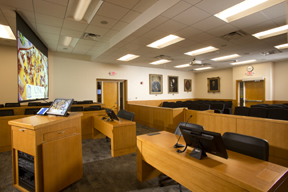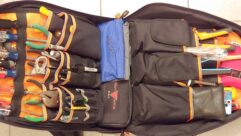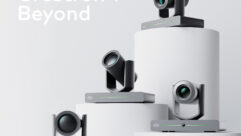
SVC Podcast – Show Notes – Show 157-1
In this edition of the SVC Podcast, SVC Contributing Editor Bennett Liles talks with Billy Morris of Kontek Systems in Durham, North Carolina about their AV installation for the moot courtroom at the University of North Carolina Law School. Part of a larger, building wide renovation, the project added many modern features to the courtroom, judge’s chambers and jury room and it allows the facility to operate in classroom mode or moot court mode. They discuss the Extron control system and the features the system has for training law students in a real world courtroom setting.
For Part 2
Links of interest:
- Kontek Systems of Durham, North Carolina
- Extron XTP CrossPoint1600 Digital Matrix switching System
- Extron Annotator 300 installed in the UNC courtroom
Download Podcast Here:
https://s3.amazonaws.com/nb-svc/public/public/157-1_Kontek_Systems_Billy…
From Sound & Video Contractor Magazine, this is the SVC Podcast with Billy Morris of Kontek Systems. Show notes and equipment links for the podcast are on the web site of Sound & Video Contractor Magazine at svconline.com.
Up until a couple of summers ago, the University of North Carolina Law School was making do with a fairly primitive AV setup in their moot courtroom but Kontek Systems of Durham, North Carolina changed all of that. Kontek’s Billy Morris is going to tell us how that project went and what law students and professors can do in there now. That’s coming up next on the SVC Podcast.
Billy it’s great to have you with us on the SVC Podcast from Kontek Systems in Durham, North Carolina so tell us something about Kontek Systems. What sort of projects do you like to get into?
Sure, Bennett. We’re about a 28-year-old company, locally-owned and locally-grown. We’ve been here in Durham the whole time and we’re primarily a design/build integrator. We do projects mostly here in the triangle region of North Carolina. That’s where most of our business is. We do branch out through the rest of North Carolina and some out of state work occasionally. But we’re about a 28-person company and kind of pride ourselves on our quality of work and our responsive service and our support of our clients. We basically have three market places that we serve that are our niche. Most of our business I would say is in the higher ed market particularly in the graduate school level of program. We do a work at law schools, business schools, medical schools, nursing, dental rather than undergraduate classroom work although we’ve done some of that over the years. We also do quite a bit of work in the medical world. We do presentation systems and installations in both clinical spaces and procedure rooms as well as administrative and conference spaces supporting physicians and their work. And then also we do a fair amount of corporate work; boardrooms, video conferencing rooms, digital signage, things of that nature. [Timestamp: 2:27]
Alright and this was a courtroom.
Yep. This was a courtroom at a local university, The University of North Carolina at Chapel Hill. It’s essentially the flagship law school of the UNC university system here in North Carolina and it was a fun project. [Timestamp: 2:44]
Okay, and I think it had been a while since they had renovated the moot courtroom with AV equipment.
Yeah.
And what capabilities did they want to add?
It had been a while. You would have probably been amazed at the before and after pictures. This room probably literally hasn’t been upgraded since the 70’s. It had burgundy carpet and walnut paneling and AV was all kind of cobbled together analog stuff that just didn’t suit their needs any longer. So their goal was to give the room a complete facelift aesthetically and modernize the room itself and then bring all of the AV technology up to current digital standards. And a great project and they got a great result. I can tell you more about the systems that we installed. [Timestamp: 3:33]
Obviously from what you mentioned before, Kontek Systems is no newcomer to doing courtroom AV. You’ve done quite a bit of that.
That’s right. We have work that we’ve done for the North Carolina and the federal court systems with locations in North Carolina all over the state and it seems like we’re always heading out to do another project for them. It’s good work and those courtrooms represent the real world environments that these law students are being trained for over at the law school at UNC. [Timestamp: 4:00]
Yeah, you guys have done a lot of teaching courtrooms also with the law schools at Duke and North Carolina Central University.
That’s right. We’ve had a good mix of work in the federal courts all over North Carolina and in our two other local universities which are also very good clients of ours.
And the focus of this new system, I believe is on Extron switching and signal extension so tell me about the Extron system you installed there.
Right. We engineered a system based on at the time a fairly new XTP digital matrix switching system from Extron. It’s great equipment. We’ve worked with Extron for a couple of decades and they build pretty much bulletproof stuff. And we felt like this would have represented the most flexible and capable switching system that was out there. We also ended up installing it because of the need that they had for annotation. The Extron annotator device which was again fairly new at the time but has proven to be a real winner for this project. [Timestamp: 5:06]
That’s great when you install something that’s pretty new at the time but it eventually turns out to be a staple of the industry and few if any bugs in it.
That’s right. We are certified to do XTP installations but that was – I think that was our first larger-scale XTP job so we had some work to do to get configurations done and we learned a lot during the process. But it turned out really well and I think our clients are very pleased with the results. [Timestamp: 5:33]
Of course this is a training environment but you equip it just like a real courtroom and a number of people would have control of what the jury sees. So who exactly can control the input to the jury displays?
The room has two functions. One is to be a mock courtroom for training purposes for law students. The other is it functions as a classroom environment for relatively small classes that are taught in there. So in courtroom mode when you’re actually teaching the methods of dealing with actual courtroom environments you’ve got, of course, attorneys’ tables, you’ve got the prosecutors and the defense attorney tables. You’ve got the judge’s bench, the witness stand. In this case there was a presentation podium in the center of the room that was built on a turntable that lets it spin around 180 degrees from facing the judge’s bench when a lawyer is – or an attorney is addressing the bench and in classroom mode you spin the lectern around and it addresses the gallery where students are seated as students in a learning environment. You’ve got the jury box, of course, and each of those locations has monitors and can view and hear evidence being presented. The two places where folks can control the system and what sources are selected are the presentation podium and at the judge’s bench. [Timestamp: 7:00]
Okay, so the judge can have ultimate control over what the jury sees based on what is deemed to be admissible or not.
That’s right. I think the idea is that you’re really trying to simulate a real world trial where the judge would perhaps preview some evidence that an attorney wants to present and it is not viewed in the public. There’s a large flat panel at the front of the room that the gallery can see and the jury can see it. There are 12 jurors of course and there are six monitors in the jury box, one for each of the two jury chairs. So the judge can block any video from appearing on the jury box or even the witness stand while they review it and then they would approve that for public viewing. [Timestamp: 7:46]
What was your timeline on this thing and did you hit any snags anywhere?
Well it was long in coming and planning, but when it came down to installation time because of some challenges they had in building renovations – again it being such an old building – we ended up having about a two-week compressed actual onsite installation time to do all of our site work which included the courtroom and a jury deliberation room and the judge’s chambers which had modest systems in them. But I think the challenges for everyone really were the age of the building and the fact that it had asbestos. It needed abatement and some of the infrastructure, electrical and conduit and lighting and all really had to be torn out all the way and rebuilt from scratch. So I think every contractor involved in the job had more work on their plate than they might have anticipated. [Timestamp: 8:38]
Oh, well if things weren’t interesting enough, just throw in a little asbestos.
Of course, yeah. In fact we’d be doing this podcast right now from the courtroom. We really wanted to do it but there’s some remaining areas in the building that asbestos abatement is going on over there right now and so they’re sealed off and we couldn’t get in there today. [Timestamp: 8:57]
Well, it looks like you may have had a significant obstacle with the courtroom’s concrete floor.
Yeah. The concrete floor, half of the room was kind of built on – almost on grade; very small crawlspace underneath, places where we had to get signal cables to and from. So it was a challenge doing core drills and we ended up finding other routes for wire. The contractor on the job was just great and they worked with us to help find pathways for wiring cable that otherwise would have been tough to handle. [Timestamp: 9:29]
And it’s not all flat screens. You’ve got an NEC projector in there someplace?
Right. If the room is in classroom mode there’s a large motorized projection screen flush in the ceiling that comes down and an NEC projector serves that need and it’s viewable from the gallery where the students are sitting. In courtroom mode the projector is off and screen up and so everything is flat panel at that point. [Timestamp: 9:56]
Did you install anything in the judge’s chambers?
Yeah. The judge’s chambers really is just a modest system with a large flat panel and a laptop input. It’s set up for basic web conferencing but not much more than that. The jury deliberation room has a similar AV presentation system where jurors could learn to review evidence from a trial they have just heard and then the only twist in there is they want it to be able to monitor both what is being said and see the jurors with a camera. So we’ve got a network camera in there and a couple of ceiling microphones that will be controllable on the UNC network from a distant location and they can keep track of juror progress and kind of hear what they’re saying and help coach them on that sort of thing. [Timestamp: 10:48]
Yeah, these people aren’t technicians, especially the jurors so you had to train the lawyers, the judges to operate everything. Did you have to make any tweaks based on how things went with that?
Well the two small systems have very modest Crestron button panel control systems that were very simple to learn so that wasn’t a problem. The touch panel systems in the courtroom were certainly more complex but we’ve got a great team of clients over there that we’ve worked with for years and they’re really good at doing kind of their own in-house training after the fact and they support their faculty and users really well. So we did an initial training session where we were able to kind of hammer out any small changes they wanted to make in system operation. We worked quite a bit in the beginning to plan this thing out to the point where by the time we deployed our user interfaces in the room and did our training they pretty much had what they said they wanted and it worked out really well. [Timestamp: 11:46]
Well, it sounds like it did and in Part 2 we’ll get into how you set up the sound system and its capabilities and the wireless mics. It’s been great hearing about this one. Billy Morris, Senior Account Manager at Kontek Systems and the AV upgrade for the moot courtroom at the University of North Carolina Law School. We’ll see you in Part 2.
Thanks, Bennett. My pleasure.
Thanks for joining us for the SVC Podcast with Billy Morris. Show notes and equipment links are on the website of Sound & Video Contractor Magazine at svconline.com. In Part 2 next week Billy will tell us about the courtroom sound system setup and installation. That’s on the next SVC Podcast.










